#1000 B.C.E.
Explore tagged Tumblr posts
Text
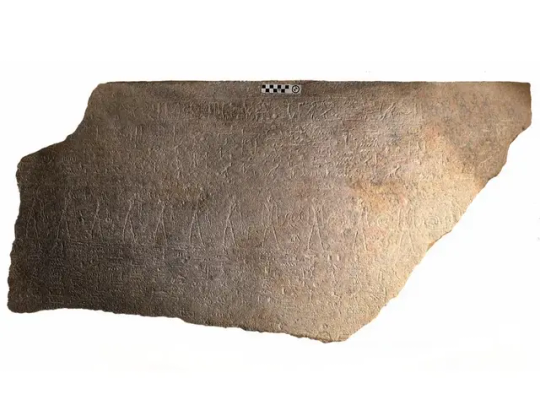
Ramses II’s Long-Lost Sarcophagus Has Finally Been Identified
An Egyptologist recently concluded that a fragment of an overlooked granite coffin bears the great pharaoh’s name.
Ramses II, a pharaoh who ruled in the 13th century B.C.E., is one of ancient Egypt’s best-known rulers. The 19th-Dynasty king expanded Egypt’s territory into modern-day Syria, fathered some 100 children and boasted one of the civilization’s most ornate coffins. But the carved granite sarcophagus built to house that coffin has never been identified—until now.
Frédéric Payraudeau, an Egyptologist at France’s Sorbonne University, recently re-examined a sarcophagus fragment found in the ancient necropolis of Abydos in 2009. At the time, experts posited that the engraved stone box had held the remains of two different people at different times, per a statement from the French National Center for Scientific Research. The second occupant was Menkheperre, a high priest who lived around 1000 B.C.E. But the first proved to be more difficult to pin down: Archaeologists only knew that they were a very high-ranking figure from the Egyptian New Kingdom, reports Live Science’s Jennifer Nalewicki.
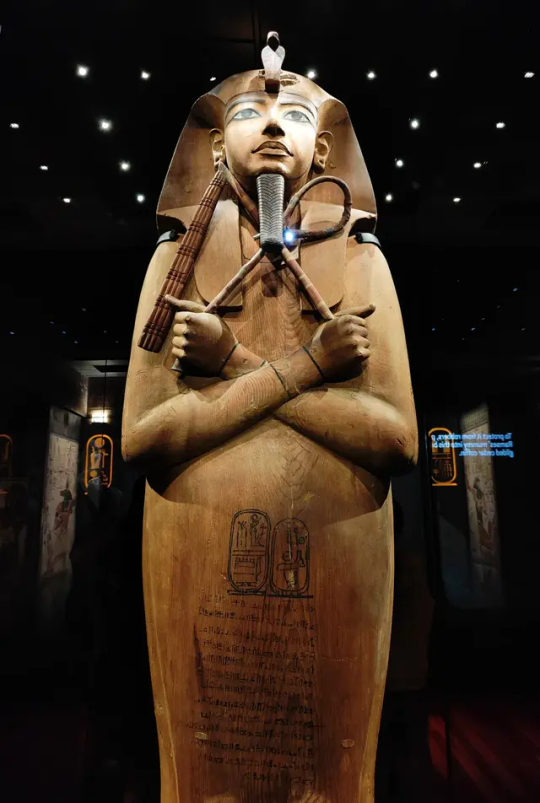
Ramses II's cedar coffin.
When Payraudeau studied the sarcophagus fragment’s inscriptions, including a previously obstructed and misidentified cartouche (an oval that typically encloses a royal name), he realized the hieroglyphs bore Ramses’ name. The scholar published his findings in the journal Revue D’Égyptologie.
Ramses’ reign lasted around 67 years, making it one of the ancient civilization’s longest. Dubbed the “builder pharaoh,” Ramses commissioned many temples throughout the region. As Payraudeau says in the statement, finding an ancient Egyptian site that isn’t marked with Ramses’ name is rare. The king even added his name to monuments built before his rule.
Ramses’ death in 1213 B.C.E. left a layered physical trail, thanks to multifaceted Egyptian entombing techniques and numerous pillagings of the Valley of the Kings, which held his and many other royal tombs. The pharaoh was buried in a gilded wooden coffin that was nested inside of an alabaster sarcophagus and a larger granite sarcophagus. Later, the coffin was stolen, the alabaster sarcophagus was shattered by looters and the granite sarcophagus—from which the fragment in question originated—was reused by Menkheperre.

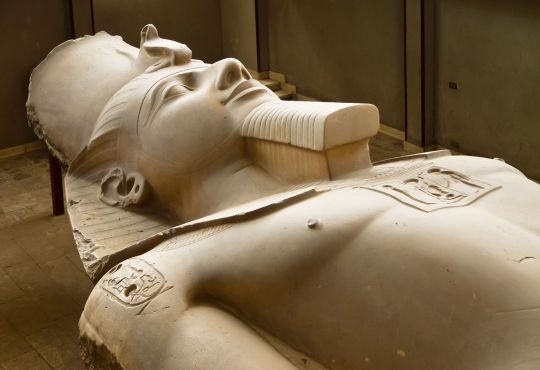
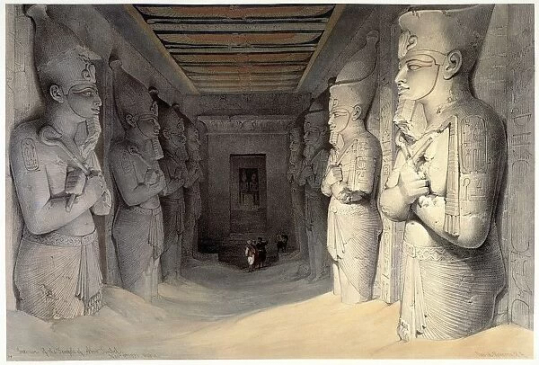
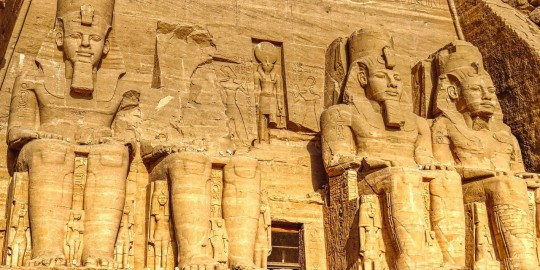
As Payraudeau explains, the Valley of the Kings was plundered numerous times during ancient Egypt’s 19th Dynasty, an era of economic and social crises that led to scarcity, forcing even royals to reuse funerary objects created for their predecessors.
In 1881, Ramses’ mummy and coffin were discovered in a hiding place in the temple complex Deir el-Bahari, which housed the remains of 50 other members of the nobility, including the pharaoh’s father, Seti I, according to the Egypt Museum. Since then, the gold coffin and Ramses’ mummy have been exhibited at museums around the world. Whether the sarcophagus fragment, which is currently stored in Abydos, will one day go on display, too, remains unclear.
By Sonja Anderson.
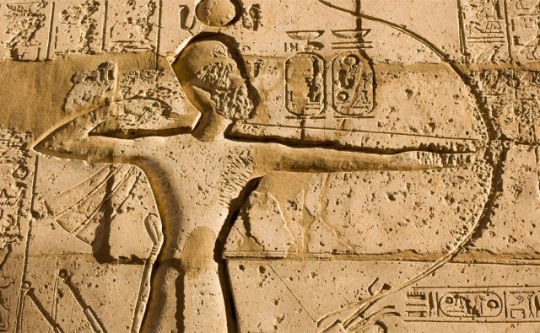
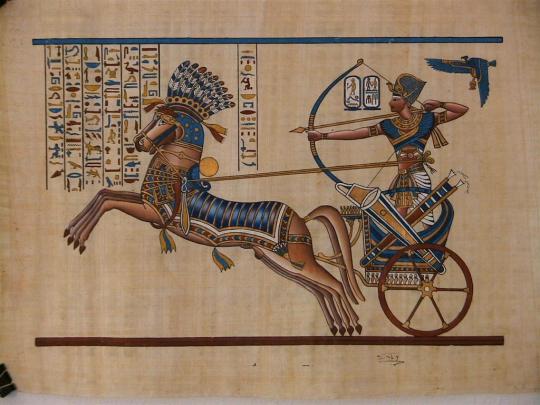
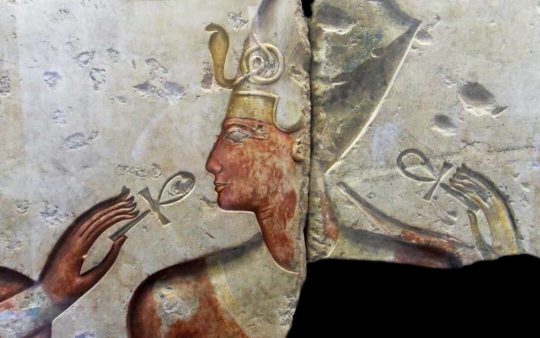
#Ramses II’s Long-Lost Sarcophagus Has Finally Been Identified#Ramses II#sarcophagus#ancient artifacts#archeology#archeolgst#history#history news#ancient history#ancient culture#ancient civilizations#ancient egypt#egyptian history#egyptian hieroglyphs#egyptian pharaoh#egyptian mythology#egyptian gods#egyptian art
82 notes
·
View notes
Text

Vessel With Two Feet
Unknown Artist
c. 1000 - 800 B.C.E.
Is this like a cross between the Luggage and a golem? Or is it more likely to have come out of Unseen University?
#art history#discworld#gnu terry pratchett#terry pratchett#pterry#history#art#discworld and roundworld art (history)#discworld and roundworld art (history) series#the luggage#golem#unseen university
87 notes
·
View notes
Text
Turian Culture Meta - Ferus Style
Yeah so -- ready to descend into crazyland?
We’re gonna dive into some meta thoughts I have about what sort of cultural educational and military system would produce the interesting client-state relationship between the turian Hierarchy and the Vol Protectorate.
Disclaimer: The opinions of the author (me) are naturally my own and are not intended to argue for or against anyone else’s ideas. This is not even intended to be an interpretation of canon, in point of fact. Canon doesn’t have much to say about things that actually interest me. -shrug-
This is my ‘plausible’ version of conceptual options and social structures that canon either glosses over or fumbles entirely. Because it’s just not interested in these ideas, really ... BUT I AM. :D
If you find any of these concepts compelling? Fantastic, please liberate them! Go and use them in any or all transformative work with or without attribution.
I really Do Not Want to be the only one writing this stuff, so... be welcome!
Full post (long) underneath the cut.
The Situation
The turian Hierarchy makes first contact with the Citadel some 1000 years after the volus have drawn up the Unified Banking Act (300 B.C.E.) and have a thriving economic network of colonies after discovering FTL travel. The volus in point of fact have more than a millennia of advanced experience in working with multi-species ventures and are a pillar of the galactic economy long before the turians finish off their brutal Unification Wars.
If you took just the game’s on-screen hints as fact, none of this is evident in the galaxy by the time Shepard encounters volus on the Citadel. They’re treated as a sort of minor curiosity in comparison to the turian characters -- whether because of the mask, or just because economics is “less interesting” in a AAA-shooter. OH WELL.
Another interesting element is that the volus are “accepted” as a protectorate of the Hierarchy around 700 C.E., shortly after the Krogan rebellions.
To my mind, this is translation for: the Hierarchy’s war economy in the aftermath of the Krogan rebellions would have collapsed without the intervention of volus administrators, economists, logicians, and other bureaucratic types. What the Hierarchy DOES have of a peacetime bureaucracy was likely or nearly entirely trained and reformed by the Vol Protectorate’s extremely professional civil service. Fight a series of wars and warlords in the colonies for around 1000 years while someone else is running the galactic banking system ... and you’re probably woefully behind the curve in that area, just saying.
When you’ve “elevated” one warlike species (the Krogan) and then been surprised that they’ve gone on to aggressively contest the rest of Citadel space, it even seems likely/possible that this was a grand strategic bargain on the part of the Citadel species to avoid the turians becoming a “second” Krogan incident.
A values-driven and rules-based collectivist civil society that managed to transition to a peacetime footing without an accompanying economic collapse would be a much more stable galactic force ... plus you get the opportunity to fill in C-Sec ranks, develop a galactic security fleet (employing turian Dreadnoughts), and use those related tasks and duties to bring turians (an otherwise very militaristic society with a historical doctrine of total war) into better compliance as galactic citizens. In essence: the Vol Protectorate gives the Hierarchy something to protect rather than conquer.
Naturally, turian cultural perspectives on the purpose of the Hierarchy and the relative values of the culture probably run the gamut from the more imperialistic Unification and pre-Unification end of the spectrum to the more socially/galatically communitarian version of the Hierarchy, itself, as a participant in creating civil society within the Milky Way.
When in doubt? I prefer to view individuals on a spectrum or continuum of different possible viewpoints -- and to prefer that a full spectrum of interpretations be available to my characters. So that’s the type of environment I’d use as backdrop for, say, a fic.
Education (Given: The Situation)
Which takes us back to the Hierarchy’s mandatory service culture and boot camp at age 15, with mandatory service from age 15-30.
“Public service” as opposed to private industry is more a matter of organization and aims than it is a limitation of ‘choices.’ Take, for instance, the example of ‘national’ industries owned by a state. Any state-owned enterprise might conceivably count toward ‘public service’ citizen credit. These enterprises could include everything from arts museums and public art projects (ala the Works Projects Administration of Roosevelt Depression-era US policy) to industrial fabricators, dockyards, and other collectively owned and operated institutions.
Note that I also don’t equate state-owned industry to CENTRALLY-PLANNED industry! You might, in a turian society that prizes both individual accountability AND public service, have for instance a federated system of local control within a centrally-organized public works or other department.
Fair warning: this is my professional bureaucrat side talking. There are MANY aspects of infrastructure, particularly public works infrastructure, that are site- and context-dependent. Central planning of these features quite literally doesn’t work outside of administration and funding (which you WANT organized in larger packages if possible, to secure the best possible loan terms).
I also imagine that a public service-oriented society would work on incorporating the economic fates of its outer colonies into the trading lanes and patterns of the central Hierarchy (in order to secure greater loyalty and collective bargaining power, alongside the Vol Protectorate’s economic management engine).
So what would education in a “man-of-action”/”public service” society look like? I’d think more a system of apprenticeships and practical qualification or on-the-job (OJT) training and certification where available!
A boot camp experience is usually important both for training in values and standard procedures, so it’s less likely to vary appreciably between any one place and another beyond basics related to climate and environment. I’d expect boot camp training to be purposely standardized -- individual accountability doesn’t necessarily lead me to conclude that turians would be keen to judge themselves on anything other than “demonstrated merit” (and testing would be ONE part, but probably not the most significant -- outside of genuine performance on practical tasks, and the ability to produce measurable results!).
Pre-boot-camp education would likely be designed to expose juveniles to as many professions as possible -- there’s a bit in the codex about the turian respect for “knowing one’s place” and finding a comfortable place where the individual best serves the community (rather than individual prestige or economic gain). This would also track with turians being ‘poor’ entrepreneurs (i.e. less inclined to start their own businesses for profit, or with less opportunity when they’re in State-mandated service) ... and account for some of the distrust of ‘merc-born’ turians who chose to opt out of the traditional Hierarchy structure.
I’d also expect a classical turian education to include emphasis on health, community values, and being able to communicate in a general way with their volus partners/collaborators in areas that are less often viewed as strengths of turian culture (aka: economics and business, anyone?).
If turian culture is truly militaristic and communitarian, both, and formed around a sort of military hierarchy, that society will also be shaped by what doctrine views as effective deployment of force and possible missions and required capabilities In military terms, this would be defined both by a theoretical ‘ideal’ force structure and various desired concepts of operations.
Military Doctrine (Given: The Situation)
So, what capabilities would be valuable for the turian Hierarchy to provide to the galaxy? What are its internal needs? What are the needs of its closest allies and partners?
We already know (or suspect) that Dreadnoughts are one sign of military status. These immense warships are required to secure and hold space stations and other important remote outposts, alongside the smaller cruisers, frigate wolfpacks, and other space Navy-type forces.
We can also consider C-Sec (civil and criminal investigation on the Citadel, security for ports, anti-smuggling operations, etc.) as a separate civil branch and outgrowth of skills are learned and taught within the Hierarchy and something of a stereotypical (and desirable!) turian job outside of Hierarchy space.
Other valuable services provided by the Hierarchy include staffing and operating a force (32 fleets!) large enough to secure not just Hierarchy space but also to protect the Citadel. Turians canonically value combined arms and disciplined maneuver warfare, decentralized command-and-control, and are also the primary military arm and security force for the rest of the galaxy.
In summary: the turians are so good at staffing and maintaining fleets that the rest of the Council species seem to prefer handing these civil functions over to the turians in proportion to their relative expertise and cultural strengths.
All of the above implies that turian culture would need to be an extraordinarily flexible (structurally) society, if individually somewhat set and rigid in expectations and values for fulfilling assigned duties.
I’d believe that assignments, once given, were equivalent to anyone else’s ultimatum! I’d also imagine that turians would find it VERY personally important to seek out roles where they could fulfill all potential assignments to the best of their individual abilities, and that ‘finding’ that place/role in society would be akin to a life path.
Amateurs Study Tactics
A short aside that warfighting ability, alone, at least on an individual level, is a minor strength in comparison to building an effective collaborative combined arms force. The organization required at an individual level? Not much! Just personal training and supply.
Problems mount as soon as the force expands in size, complexity, and desired mission capabilities. I could see volus economists and logicians, as well as military scholars, being the preeminent organizers and administrators of turian force structures. I could see the volus economic influence being a quite effective force multiplier for the turian Hierarchy, in terms of creatively organizing fleets and their sub-units into autonomous mission-capable interchangeable “parts” which all know how to work together and communicate to achieve complex adaptability and integration of vastly different forces, hardware, and weapons systems at a variety of scales (from galactic, to orbital, to low-orbit, to planetside ground).
Which leads us to ...
Professionals Study Logistics
This is just the study of the application of “effective force.” What makes a force effective? It needs to be supplied with personnel and materiel such that it can accomplish its assigned mission -- preserve the capability of the force through the supply of the necessary tools at the right time, alongside the ability to maintain, repair, replace, or rotate those tools as needed.
A force that has been improperly positioned (is too far forward of supply lines, or too far in the rear to be applied at the right time) is by definition an ineffective force. It is unavailable to accomplish the mission.
There’s a long, rich tradition of economists studying the choice behaviors of nations seeking war, the application of deterrence, and the conditions of victory and defeat on a multitude of different battlefields in different historical and cultural contexts. We get just about NONE of this (barring some high-level generalizations) in Mass Effect, proper!
If we did, we might have seen a bit more nuance in illustrating the Vol Protectorate as not just the economic backbone of Citadel space, but also the preeminent experts in military grand strategy and supply. They’re likely the most closely associated Citadel species and have the most experience collaborating with turian systems of organization! The volus would be just as good at turian military history as turians are, if not BETTER observers and critics on the logistics/economics side, in terms of patterns of thinking and history!
At some point I’m going to have to write the “lessons learned” memo on the First Contact War from the point of view of an eminent volus logistician and economist (ala Thomas Schelling).
Because I’m a nerd, and if the FCW was a failure due to logistics and supply errors? You can just BET the volus were kept out of the First Contact loop as a some sort of power play on the part of less-qualified frontline personnel... no, they’re not salty about that, why do you ask?
-
HATE ME YET? Yeah, I can’t stop thinking about this stuff, either ... and now you know why my fanfiction is the way it is. :D
#mass effect meta#turian#volus#apparently i have TOO MANY THOUGHTS#ferus chats#my way of thinking#shrug#jazz hands#it is what it is
82 notes
·
View notes
Note
DUDE I HAD MY FIRST ASSIGNMENT IN HISTORY YESTERDAY AND I HAD TO ANNOTATE (highlight/write in the margins) 9 PAGES OF THAT. 1000 YEARS IN 9 PAGES 300 B.C.E. TO 300 C.E. DUE YESTERDAY (I submitted it tho don't worry but ain't no way that was our FIRST assignment) (I think I accidentally signed up for a college level class??😭) (well it's advanced history but that doesn't count😭)
NINE PAGES⁉️⁉️😨 I WISH U GOOD LUCK BCS NINE PAGES IS WILD…
2 notes
·
View notes
Text
Exploring Amman
September 14, 2024
Salam
Today the 8 of us under the leadership of our of fine trip leader, Nader, set out to discover Amman, a city of 5 million people that has been constantly inhabited for the last 10,000 years. No easy task - but luckily we had all day. So much to learn, to understand and to explore. Of course I’m being facitious as it would take years to just study of history of this city - but we will try to get what we can with the time we have.
Amman is a city of hills - 7 to be exact. Amman, Jordan is the world’s oldest constantly inhabited city, and if historical records are anything to go by, there have been people living in the region since 7250 BCE. We drove around a tiny bit of this huge city and headed to the Citadel. WOWZA!! Most of the structures still visible at the site are from the Roman, Byzantine, and Umayyad periods. The major remains at the site are the Temple of Hercules, a Byzantine church, and the Umayyad Palace.
Behold the Roman Temple of Hercules.

I’m not going to lie here - I never heard of the Umayyad period - so it took some time for me to put this into my brain.
From Britannica:
Umayyad dynasty, (661–750) First great Muslim dynasty. It was founded by Muʿāwiyah I, who triumphed over the Prophet Muhammad’s son-in-law, ʿAlī, to become the fifth caliph. He moved the capital from Medina to Damascus and used the Syrian army to extend the Arab empire. The Umayyads’ greatest period was under Abd al-Malik (r. 685–705), when their empire extended from Spain to Central Asia and India. Their decline began with a defeat by the Byzantine Empire in 717

The roof is new - really new 1998!

The Byzantine church

As we have witnessed around the world, the conquering group destroys the conquered's most sacred building and rebuilds atop the ruins. Nothing new here and we could see the different “level” in the work that is on-going on the Citadel. Most of of the damage that we saw on The Citadel was from a major earthquake in 749 CE.

The Citadel has a wonderful very small museum and I enjoyed it greatly. The following info is really for me - because this museum laid out by “ages.” It was no surprise to see lots of artifacts from every “age."
These are the archaeological ages generally cited, particularly as they pertain to human history in the Middle/Near East:
Stone Age—2,000,000 to 3300 b.c.e.
Palaeolithic—2,000,000 to 10,000
Neolithic—10,000 to 5000
Chalcolithic/Copper Age—5000 to 3300
Bronze Age—3300 to 1200 b.c.e.
Early Bronze—3300 to 2200
Middle Bronze—2200 to 1550
Late Bronze—1550 to 1200
Iron Age—1200 to 586 b.c.e.
Iron i—1200 to 1000
Iron iia—1000 to 925
Iron iib—925 to 586
As I mentioned people have been in this area a VERY long time.


This little guy is from 6500 BCE!
BUT before I go on it is necessary for us to understand the following terms and how these “terms" plays into the history of Jordan.
The Lavent - literally meaning the lands east of the Mediterranean Sea - including Crypus. Dark green in the picture below.

The Fertile Crescent

The Ottoman Empire

Colonization

OK - so what is up with the maps? All of these maps are the land mass “Jordan” but the country of Jordan with its current day borders are new - 1946.
I lifted the info below from Wiki and I’m leaving in some of the links. The reason I added this is to give you an idea of the long and complex history of this region.
Modern-day Jordan has been inhabited by humans since the Paleolithic period. Three kingdoms emerged in Transjordan at the end of the Bronze Age: Ammon, Moab and Edom. In the third century BC, the Arab Nabataeans established their kingdom centered in Petra. Later rulers of the Transjordan region include the Assyrian, Babylonian, Roman, Byzantine, Rashidun, Umayyad, Abbasid, and the Ottoman empires. After the 1916 Great Arab Revolt against the Ottomans during World War I, the Greater Syria region was partitioned, leading to the establishment of the Emirate of Transjordan in 1921, which became a British protectorate. In 1946, the country gained independence and became officially known as the Hashemite Kingdom of Jordan
The entire concept of “nationalism” is also new. Prior to the establishment of “borders” - something the people in the region had little to do with - there was no such things as a “Jordanian.” Nader told us that while his generation embraces being “Jordanian” his grandparents had no such belief.
The Flag

The flag explained:

Remember the official name is The Hashemite Kingdom of Jordan - but the “region” that became Jordan was part of several caliphates over the years. More maps…


The flag honors the history of the “Jordanians”. The 7 pointed star is for the 7 hills of Ammon and the 7 verses of Al-Fatah - the first chapter of the Quran. Nad told us the verses and their meaning and it is about being a good human, humble, serving others and asking for God’s guidance. (Of course that is my take away and I mean no disrespect if I have left out things.)
So - on to the next thing - lunch.
We were welcomed with a small cup of coffee with cardamon - delicious.

Then lots of bread and dips. The hummus is out of this world!!!

We finished with barbecued lamb, chicken and kabobs.


Next we headed back to the hotel for some down time. On the way we talked about water. It is scare and very expensive. All the buildings have water tanks.


The water tanks are filled by the city/region/municipalities on a certain schedule - usually one week, but where Nad lives it is every 3 weeks. The tanks are metered and depending on the area and height of the building an additional water pump might be necessary to get the water to the tanks. The plumbing for the water fill is internal. Water pressure remains a problem that prohibits the water from being free flowing. Water charges vary depending on usage and sometimes it is necessary to buy water from a water truck at a much higher rate. The amount of tanks you get depends on the size of the family living in the home. In Michigan, we take unlimited access of clean water for granted - no doubt - and being in a region where water is so limited makes me appreciate that luxury.
Mark and I opted for naps during our downtime and then a short walk to around the hotel grounds and pool.
At 18:00 we headed down to old town to experience the market and do a little people watching. LOVE IT!


My conclusion: Lots of smokers!! Nad told us about 25% of women smoke and 50% of men. I never saw a woman smoking during our walk. Smoking - FYI - is allowed in restaurants! 🤮. Variations on clothing range from supper conservative - to western ware but still quite modest. We saw woman wearing niqab, chador and hijab head coverings - but most often it was the hijab.

They come in lots of beautiful colors and prints. We also saw plenty of women wearing no head covering.
Men - just looked like men, wearing whatever they wished although we did see a few men wearing a Thobe.

All were shopping and seemingly enjoying theirselves. Again - I see we have more alike than different
We saw a Mosque that has been in use for centuries and we were lucky enough to be standing right in front of it as call to prayer was announced.
We finished the evening in a little restaurant that specialized in falafel. Let me just say YUM - and although I can’t have any of the bread options, I am not going hungry and trying to deal with my hatred toward my fellow travelers who are mopping up all the wonderful side dishes with their wonderfully smelling bread. (Just kidding - kinda)

I’m not sure when we got home - but we were tired. I did some research of things I had experienced during the day - then went to bed. Our first full day in Jordan was spectacular!!
Salam.
1 note
·
View note
Text
Prehistoric/Stone Age
1000 B.C.E. to 799 B.C.E. (the dates are wrong. Prehistory is too long for me to play from discovery of fire to the bronze age)
At present, I'm planning on 4 game days = 1 year. I tend to be bad at that, so that is very likely to change to 3 days, and maybe 2 days
2 week seasons
Aspirations can be changed once they're completed, unless a sim joining the household has one that doesn't fit the era. Traits can be changed if they're not era-compatible but are otherwise randomized after the original founder(s) (Gen 1).
A generation changes when there's a new head of household. A head outlives their child and the next head is their grandchild? That's the next gen. But they're counted according to birth gen, so it would be Gen 2 and Gen 4 (for making the family tree make sense.)
No fame, no uni, maybe school? Send the kids off to learn with the village elders while the adults get some work done?
Everyone gets a grave, but not for a while (this is actually kind of historically accurate). Headstones/urns must be kept until the time comes to build tombs.
Custom aging, but aging is on. No cakes = sims aging up on their own.
No marriages for the main household, but MCCC can marry other households, both to keep them reproducing and to keep some sense to it.
Jealousy turned off, because no official relationships.
Matriarchal matrilineal society. They did not have marriages or other official relationships (according to my interpretation, at least), so there would be no knowing the other parent unless the child looked like them. Person who got pregnant to person they gave birth to if possible, with a preference for those who can give birth as heirs. If heir is only set to get others pregnant and it doesn't get changed (for my sims, anyone who wants to get pregnant can), their heir is the one who looks most like them, their biological child or not. Adoption possible, but would be less likely to be the heir. Not necessary for the oldest child to be heir--the one who is best suited, according to the head of household, may be chosen.
I think I'm using LIttleMsSam's Miscarriage Chance mod to have a miscarriage and maternal death chance, but that could change to rolling at some point. If the birth parent dies, they can be pled for, but unless it ends the challenge they cannot have any more children.
Rolls for mortality for each birthday up to and including teen. Infant and childhoold mortality stayed high and mostly stable up until nearly/into the 1900s, so that will continue for a long time. The ultimate goal is an average of two surviving children per head of household, which will still be more than enough to make the family tree impossible.
End of life rolls will start at 54 for the hunter-gatherer nomad part, because that's around the life expectancy of those who lived beyond childhood. BUT if there's a major (real life, big enough for me to have found a record of it) world event that a sim survives, their next end of life roll moves forward by a year.
Random events rolled for at the start of every season (starting with the next season. I'll let them get settled in first).
Rolls for in-game events, including alien abductions, fights, in-game earthquakes, volcanic eruptions, in-game illnesses, fights, surprise holidays, vampire attacks.
Rolls for real life events that were major enough to still be known.
I'm starting in Sulani. Moving will happen, both between lots (nomadic lifestyle) and between worlds.
No jobs, but trading (selling things that are gathered or made and buying things with the money) is allowed. Bills have to be paid.
They will be hunter-gatherer nomads in Sulani until around 870 B.C.E. Many households were deleted. I kept the ones in Sulani (the lots were bulldozed, and they have a fire and a cave tent now), any role sims, and some others. MCCC dresser is great for getting them into appropriate clothes.
Start with 2 sims, 5000, and Simple Living, Off the Grid, and Volcanic Activity and/or Quake Zone. (I'll see how long OTG and simple living last.) Also Wild Prairie Grass, for reasons.
There's more, but it's more detail than anything.
0 notes
Text
0 notes
Text

Massive Find of 500 Bronze Age Relics Acquired by Scottish Museum
The National Museums Scotland has snapped up the 2020 find known as the Peebles Hoard.
When metal detectorist Mariusz Stępień’s detector pinged in the Scottish Borders in 2020, he could never have guessed he was about to uncover one of the most extraordinary archaeological finds in Scottish history. Now, three years later, this remarkable collection of Bronze Age artifacts—dubbed the Peebles Hoard—has found its permanent home at National Museums Scotland, where it continues to astonish experts with its secrets.
The Peebles Hoard contains over 500 bronze and organic artifacts dating back to 1000–800 B.C.E. The collection includes several items never before found in western Europe, promising to transform current understanding of Bronze Age Scotland, after lying undisturbed for three millennia.
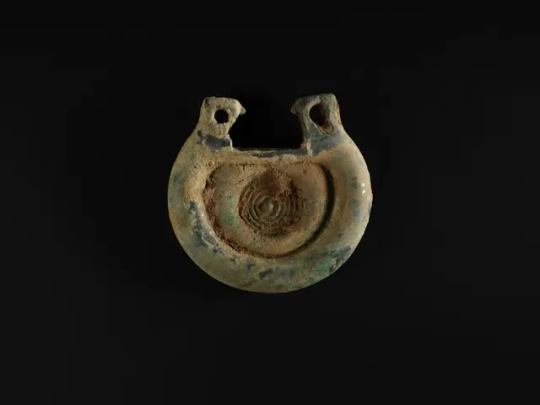

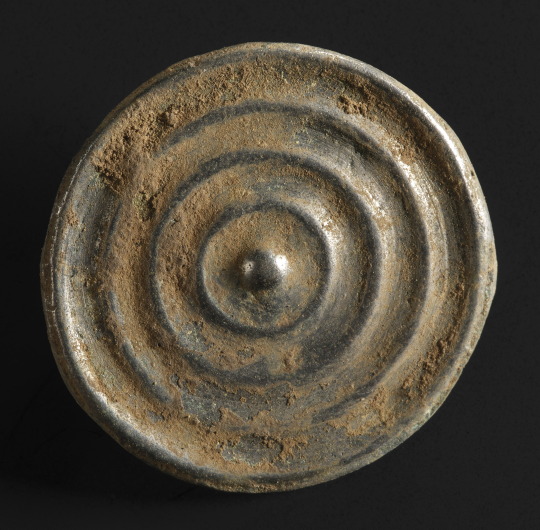
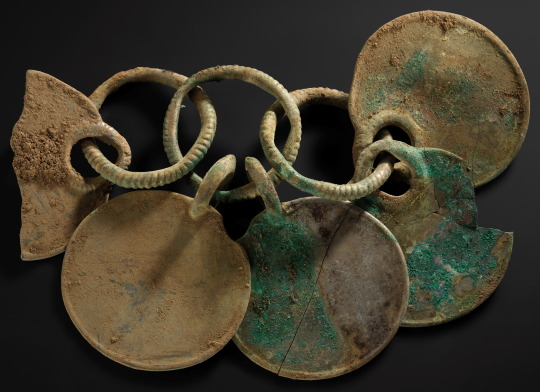
Among the hoard’s most significant finds are two rattle pendants—the first ever discovered in Scotland. These intricate objects, typically found in Denmark, northern Germany, and northern Poland, consist of interlinked bronze rings and pendant plates that would rattle when attached to horses or wooden vehicles. Their discovery demonstrates Scotland’s participation in a broader North Sea trading network during the Bronze Age.
The treasure trove’s preservation is nothing short of miraculous. A sword still snug in its wooden scabbard, delicate bronze buttons still threaded on their original cords, and intricate decorative straps that look almost ready to use, though their exact purpose remains a mystery.
An extraordinary hoard called for extraordinary excavation measures, requiring the use of an innovative retrieval process. The entire hoard was removed from the ground as a single block and underwent CT scanning at the University of Southampton’s µ-VIS X-ray Imaging Centre. This revealed some of the earliest evidence of lost-wax casting in Scotland, a sophisticated bronze-working technique rarely documented in Bronze Age Britain.

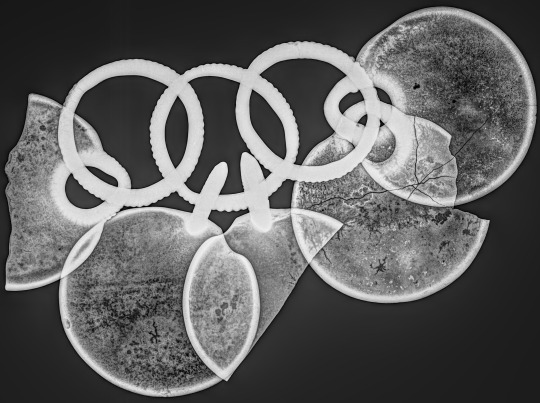

“The Peebles Hoard is exceptional,” said Matthew Knight, senior curator of Prehistory at National Museums Scotland, in a statement. “It’s an utterly unique discovery that rewrites our understanding of both Bronze Age communities in Scotland and our prehistoric international connections.”
The scanning itself proved to be no simple feat, according to Ian Sinclair from Southampton’s µ-VIS X-ray Imaging Centre. “CT scanning the hoard was certainly a big challenge due to the scale,” he admitted, but his team relished bringing their engineering expertise to such a remarkable historical find.
Now, National Museums Scotland faces its next challenge: raising funds to preserve these priceless artifacts for future generations. With delicate organic materials threatening to deteriorate, conservators are racing against time to unlock all the secrets this extraordinary collection has yet to reveal about the ancient world’s international trade, craftsmanship, and style.
By Adnan Qiblawi.

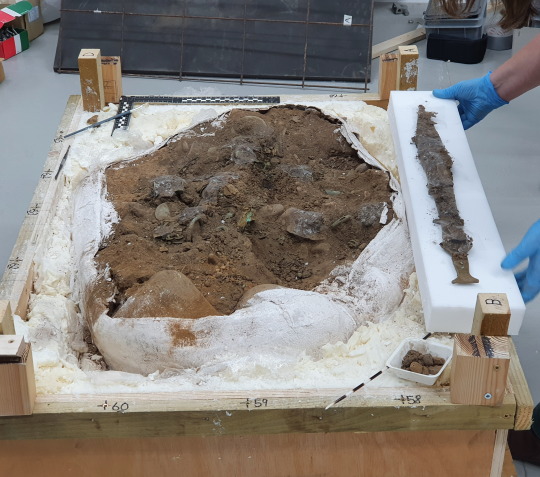
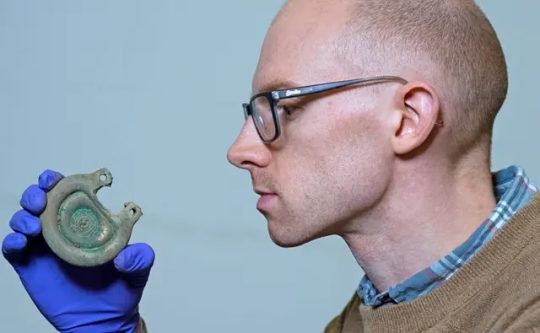
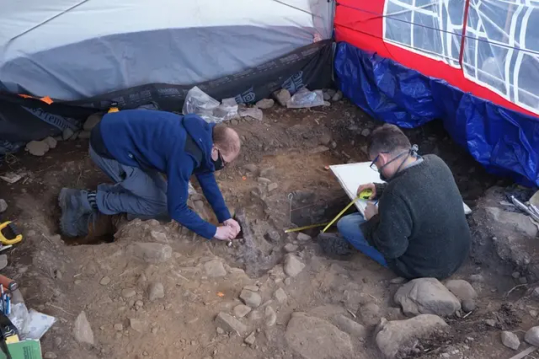
#Massive Find of 500 Bronze Age Relics Acquired by Scottish Museum#The Peebles Hoard#metal detecting#bronze#ancient artifacts#archeology#archeolgst#history#history news#ancient history#ancient culture#ancient civilizations#bronze age#ancient art
37 notes
·
View notes
Text
Dividing human history into the Stone Age (beginning two and a half million years ago), the Bronze Age (3000–1000 B.C.E.), and the Iron Age (1200–300 B.C.E.)—a scheme invented in the nineteenth century by a Danish antiquarian—misses the earliest and most important era, the Wood Age.
Read it all.
0 notes
Text
Oldest human remains from Puerto Rico contradict idea of simple island nomads

Ancient inhabitants ate a diverse diet and buried their dead in a communal spot over hundreds of years
Over 2 days in 2019, William Pestle drove a truck containing 35 carefully packed boxes from Virginia to Florida. At night, the University of Miami bioarchaeologist brought the boxes inside his hotel room for safekeeping. This was no ordinary cargo: Inside were the oldest human remains yet found in Puerto Rico.
A new analysis of the bones—some dating back about 3800 years—sheds light on the lives and rituals of Puerto Rico’s early inhabitants. Although typically thought of as roaming, nomadic fishers, the study, published today in PLOS ONE, suggests these people buried multiple generations of their dead in a single place and ate a more varied diet than previously believed.
It's commendable work, says Reniel Rodríguez Ramos, an archaeologist at the University of Puerto Rico at Utuado who was not involved with the study. The age of the remains, combined with the island’s harsh climate, can make such analyses challenging. “With what they had, they definitely did wonders.”
Puerto Rico’s first inhabitants are believed to have come from South and Central America into the Antilles archipelago around 2500 B.C.E. But very little is known about these earliest Caribbean settlers. The island’s hot, humid conditions mean human and animal bones deteriorate relatively quickly. Only a handful of sites, and fewer than 20 human burials, have been found from this period. Based on the limited archaeological record, researchers generally thought these early settlers lived nomadic lives, constantly moving around the island without establishing complex social systems or building permanent settlements.
But the newly studied remains put those beliefs to the test. In 1993, an archaeological excavation was carried out on behalf of a construction company in an area in southwestern Puerto Rico known today as Cabo Rojo. The dig yielded the remains of five individuals, along with food remains and artifacts such as stone tools and pendants. When the construction company went out of business, however, the excavated remains stayed sealed up in boxes. At first, they were kept in Puerto Rico. Later, they were kept in Virginia by Daniel Koski-Karell, a private contractor who directed the excavation.
Three decades later, Koski-Karell teamed up with Pestle, whom he knew through a mutual friend. With support from the Puerto Rican government and the Institute of Puerto Rican Culture, the duo set out see what could be learned from the remains.
Radiocarbon dating revealed the five individuals lived between approximately 1900 B.C.E. and 800 B.C.E. The earliest remains represent the oldest human remains yet found in Puerto Rico. Pestle’s group also studied the composition of carbon and nitrogen isotopes in the bones, which can provide clues to the diets of the individuals, such as whether they ate more seafood or terrestrial food, and what types of plants they consumed. They found the islanders regularly dined on both seafood and land-based animals; they also ate a lot of plants high in carbon-4—such as maize—suggesting they may have been experimenting with plant domestication. Compared with people analyzed from other ancient Puerto Rican burial sites, the Cabo Rojo individuals appear to have enjoyed a particularly diverse diet.
“They weren’t ordering from the same menu all the time as everybody else,” Pestle says.
The five burials span a period between 500 and 1000 years, suggesting some people may have settled permanently at the Cabo Rojo site, despite their nomadic reputation. “This place meant something to them,” Pestle says. Perhaps by burying their ancestors here, he adds, they were making a sort of territorial claim. Similar burials stretching over decades and even centuries have been found in early sites in Cuba, which may force researchers to rethink whether early inhabitants across the Caribbean were nomadic.
Combined with previous studies suggesting these early Puerto Rican inhabitants may have domesticated plants and built ceramics, the findings begin to tell of a more complex society than was previously thought. It “vindicates the history of populations that did not have the chance of telling [their] own story,” says Yadira Chinique de Armas, a bioarchaeologist at the University of Winnipeg. She hopes the next step will be finding and sequencing the remains’ ancient DNA, which will illuminate their ancestral connections.
Under the terms set by the Puerto Rican government, once researchers have finished analyzing the remains, they will be returned to the island—“where they shouldn’t have left in the first place,” Pestle says.
Rodríguez Ramos hopes the new results push researchers to continue to look for the remains of other early inhabitants in Puerto Rico. He is tantalized by the possibility of discovering remains at even older sites, such as Puerto Ferro in Vieques, a small island that is part of Puerto Rico, which has been dated to about 1900 B.C.E. “They are our most ancient ancestors who lived here the longest time and, unfortunately, one of the least that we know of.”
Author: Claudia Lopez Lloreda
Link: science.org
#puerto rico#puertorriqueños#science#claudia lopez lloreda#the Institute of Puerto Rican Culture#para los puertorriqueños#boricuas por el mundo#boricuas en new york#boricuas en florida#boricuas be like#the history of puerto rico#puerto ricans#educate yourselves#educational
1 note
·
View note
Photo



So far in my project, I have done my initial research into multiple varied topics and ideas that could start to become a far bigger project. Such ideas that I clinged to the most and found most interesting and possible to advance into a solid FMP was Blood, Memories and Retry, which all got their own exclusive slides dedicated to looking into what they mean and example of them found in media such as Games and Movies.
I had very minor problems during this time, as I was looking into sources and divulging information that I could use to further my research, one problem that I did encounter, however, was during my Dynasties section, this is due to the Xia Dynasty which might or might not exist.
Its existence is contested by Historians due to minor archaeological relevance and some of the earliest records, starting around 1000 B.C.E, (to 0 B.C.E,) 1070 years after their supposed rule. I, however, chose to keep it in my research as I properly explained that they might or mightn’t have existed and I believe that it's far more fun and interesting to include them as it’s a fun quirk of Chinese history and due to its importance even if its disputed.
I then moved onto conceptualising and making minor plans for potential games that I could make artwork for. I made 5 in total, but only 3 stood out to me in a way in which I wanted to make them into my FMP. One of these games was inspired by the Idea of retying, this being the game devised during my summer work in 2022, Hells New Management. This game would be a rogue like that would be a top down twin stick shooter which has active dialogue and a featured story with humour at the forefront for originality which is something quite absent from the genre, with some exclusions being Enter the Gungeon and Hades.
The idea about retying this game includes me reinvigorating the items and upgrade systems and incorporating the second idea of Blood, as in relations, further into the game from the preestablished bone of familial ties.
The second Choice is Blood and Gears, (WIP Title,) that is a completely new game, built conceptually from the ground, using the keywords devised from my mindmap such as Blood and Memories (of self) to create an introspective game about what makes you you. I wanted to be inspired by companies such as Bungie who manage to make abstract things this as power manifest itself into reality, and I wanted to try this with the memory aspect of the game, letting the player alter them and traverse them, with the idea that all memories are now computerised and can be replayed in great detail.
My third and final choice is the Almost Bizarre Case of Luther Cross, a comedy detective point and click adventure game with a dry protagonist who is surrounded by more flavourful and eccentric character that clash with his controlled and clean personality. I was inspired by Change once more, as a character I made for a previous project caught my eye and I made him into this game idea. This game takes little from my mind map however as it was a creation in the spur of the moment, what could leave it coming out half baked.
At this point, I think that continuing with Blood and Gears is my best choice moving forward. Overall, the idea is brand new and will need further adaptation and revisions to be the best it can be, while other plans like Hells New Management already has preestablished ideas and concepts that I could build off of. In spite of this, I think that choosing that over Blood and Gears is choosing the easier path, and by choosing Blood and Gears I’ll be able to make a more unique and varied game, and by starting from a brand new foundation, I’ll be able to shape it to fit any style I want instead of being limited to one I have already devised.
I decided not to choose the Almost Bizarre Case of Luther Cross due to my writing skills being subpar in the comedic sense, and when writing a game that is focused on said comedy, it would limit what the game could be to me. This could have been fixed through me researching into comedy and seeing how I could develop my skills in that department, and I would have time enough for it, but I would rather spend more time on further in depth and primary research rather than focusing on a pretty complicated medium of writing.
Heading on, with my ideas conceptualised and project chosen, I now have to make the best project I can, and to do that I have to plan out what I now have to do. I think now would be the perfect time to delve into further primary research into games, movie and art that could inspire me and that relate to the main themes that the game has as of now, being Memories, discovery of self and creationism. Some media I want to specifically look into is Bungie's conceptual art on Stasis and Strand (2021 - 2023), guillermo del toro’s Pinocchio (2022), H.R. Giger’s artistic works, review Automaton (song) by Jamiroquai, Prey (2017) and other media that might come into range later on.
After I have researched said topics, I will move onto the early work of sketching characters and locations that will later be redone and finalised into a more coherent and stylised look. This sketching will include moodboards to researched topics and other inspirations that helped forge the ideas of them in my mind. As of right now, my plan includes:
Continue research into primary sources to further the now foundation of the FMP
Create another overview going over if anything I learned or saw has changed any of my ideas or improved preexisting ones
Create rough sketches of situations, characters and locations to hone in on wanted style (helped with moodboards)
Develop sketches and finalise them, talking about how you are improving said sketches and if anything changed or problems that come up
Automaton is the 8th studio album released by the British band Jamiroquai manned by the only sole member to not be replaced, Jay Kay. The album is a different take on their previous works, putting it next to others like Emergency on Planet Earth and Travelling Without Movement shows its departure from the norm, while still having semblances of Acid Jazz it is far more Techno with R&B and Disco elements, making it far more similar to A Funk Odyssey in terms of style.
Present on this album is the track of the same name, which I am going to look into during this research.
I am looking into this song due to music being a medium that I can greatly relate to, allowing me a further and more developed opinion and also due to the songs themes relating to the advancement of technology and computerisation what is linked to my hypothetical game as the main character is a robot that has been spliced with human anatomy and this song could be used to help explore someone going through a similar situation, even if less literally.
While this song is also accompanied by a music video I am leaving it mostly out of this research as, like with most music videos, it is there for spice, improving the song but far from raising it higher in quality. It does, albeit, contain Jay Kay in a robotic hat, as is common for him.
Starting at the beginning, the name Automaton is a term regarding a machine or mechanism that is in attempt to copy or mimic a human in appearance, it can also be used in a derogatory way, as it can be said to someone who acts in a mechanical or unemotive, unfeeling way. This is the main crux of the song, as multiple verses talk about things such as, “Take my hand, Cold like a junkie, I'm an ice cold man, Why am I crying for you?” which depicts the character as unable to understand their emotion while calling themselves, “Cold like a junkie,” might show that the character is or should be unemotive, this is enforced as he goes the extra step to call himself a junkie, a drug addict, which is an uncaring and cruel way to describe someone, perhaps done as they cannot comprehend them.
In the first chorus, he laments that, “All this love I felt for you has gone away to another place, (It's a digital life,) I put my faith in a digital world where they've given me eyes without a face” what I took as them once being able to love, that this change of unemotive behaviour is a new development, (All this love I felt for you has gone away to another place,) has become the norm and a fact of life, relating to the songs message that technology is taking away the simple pleasures of life, something as simple as talking to one another.
Yet, the line, “I put my faith in a digital world,” suggests that they believed that technology would be the future, but perhaps that view has become incorrect as of now, as instead of strengthening bonds, it has given them “Eyes without a face.” I think this line could be taken two ways, one being that they cannot see what people are thinking as he can only see their eyes “without a face,” restricting their understanding of their emotions or that it has become less about feeling the emotion of one another, but rather seeing it and being unable to respond due to the digital medium that has separated us making us more formal and less emotive.
The following line states that they, “steal the moon on silver nights, remind myself I am someone, my soul is null and void tonight, I'm automaton.” The “remind myself” is obvious in stating that the digital medium has brought them down mentally and has made them feel subhuman, leaving them to remind themselves that they’re human, however I found confusion with, “the moon on silver nights.” To remedy this, I looked into spiritual connection that silver has, and apparently it has connections with the moon, absorbing its energy, it also states that the metal is able to reflect negative emotions. Perhaps the line refers that he is trying to regain his emotion that is halted by the moon, not only this, the moon also has symbolism with progress and advancements and by stealing it hes trying to go back instead of going deeper and deeper into this pit.
The next verse goes as the following, “I'm so tough, Can't you see me running? See, I can touch, Can you feel me coming? I see the world and cry for freedom. These metal eyes, they can't disguise the fact that I need something to believe in, But then I'm dying for you.” I believe this verse could be relating to the sense of being unable to tell one's emotion, “I’m so though- see, I can touch,” feels like someone trying to validate what they are feeling, but the message falls through, as his, “metal eyes,” (cold, dead, unfeeling,) cannot hide that he needs something to believe in, where he remarks that he's “dying for you,” what could show that he is still trying to grapple with his emotions, but he's hurting more that he cannot act on it, hence for saying he's dying instead of something more positive like living.
The next chorus he “said goodbye to the world I knew And took off into inner space (It's a digital life) Weren't you the ones who promised me A very different place?” Again, going to space insinuates the future and progress, referencing the digital era, (it’s a digital life,) we now find ourselves in, feeling like a new ‘world’ but its not what he was “promised,” again leading to the idea that technology should strengthen our bonds but rather weakens them.
“Hey, you got me down underground, Gettin' holed up in my cyber lounge” Is found in the bridge, and seemingly is quite simply saying that he feels stuck, while being underground a reference perhaps to his other famous hit Virtual Insanity what is also set in the future where everything is up for the worse. Cyber lounge could also probably a chat room or some equivalent, cyber as its digital and not actually real yet he still feels trapped.
Found just after, “Whatever you can do I can override it, Got a million ways to synthesise it” Is probably talking about the ease of access that technology gives to people, that they can just make anything “a million ways,” synthesise being a fun play on terms as synths are a piece of musical equipment and also means to create.
The final chorus ends the song out where he worries this,, “Feel like a man who fell to Earth But this is not where I belong They rule my life from a metal box That's windowless And I wonder where it all goes wrong Maybe this dream will stay alive But can the madness be undone?Am I the new intelligence?” This final verse references a book of the same name, where an alien comes to Earth in search of water, adding to the alienation that this song inspires. And here he finally elements if he's “the new Intelligence?” wondering if he's the first of a new generation that will only grow further apart, wondering if “the madness can be undone.”
I had a pleasant time overlooking this song and trying to derive my own ideas from its lyrics rather than solely looking at others opinions and ideas. By looking into it I have further increased my knowledge on and about the song by making it into primary research for my FMP while also using my problem solving skills to inform myself about what the lyrics could be trying to inform me about.
Overall, I think that my interpretation of the song is not too far from what other think, the song concisely talks about their views on technology, this is seen also in the use of music creation, where the band didn’t use plugins to create the synthetic sounds, rather returning to the synths of yesteryear to produce them, adhering to the message of the song, almost as if their music, while new and electronic, their music is in a similar struggle to find itself just like they are looking for their emotion.
I first heard the song back in 2018 when I first started to look through his discography far more furrowly, and I instantly fell in love with it. While diverging significantly from their norm, it is not so distant from other works of their, it might not even be their most electronic, making it feel more like an evolution of their craft instead of a full on switch up like Wonderful by Adam Ant compared to his earliest works or Hunky Dory compared to Earthling by David Bowie.
I wanted to look into this song due to its relevance to me and my project, and by having looked more furrowly into it, I have learnt that I can use aspects I have discover about it in my project.
The song leaves it vague if the character the song centres around is a robot or human, with the obvious reason being that they themselves are oblivious to the fact, this is funnily already an idea I wanted to look into in my FMP, with its main character one day realising it is part human, wondering if this was always the case or if, at one point, he was alive.
It would follow his journey in discovering who he is, just like the song is a contemplation of if they are able to feel emotion or if they are to be strained by the pain of not knowing it.
Another aspect of the song is it’s visualisations and materialisation of foreign concepts. Such ideas as, “metal eyes,” “cyber lounge,” and, “eyes without a face,” not only tell you how they feel through connotation and hindsight, but also induces an interesting mental image that you can hook onto that we can nearly all relate to due to how ingrained technology has become into our life and our dependence that has only rooted deeper. Because of this, I want to further develop my materialisation of concepts.
I was always going to try and create dreams and memories in a physical medium assisted by tech, but I could further add character and identity to characters such as the protagonist by adding inhuman but relatable aspects to their visual identity. For example, instead of just making it related to game play, I could show that a character is unfeeling or cold by removing their mouth, making them speak in another way, one that's more robotic, or someone who has no care about their actions could be seen without eyes or a covering of some kind.
All together, I think it was extremely helpful and a good investment of my time to look into this due to how it has allowed me to further my understanding of my topic by looking at another's own ideas about how they feel about becoming more connected with technology. However, I do think that, while I like the song and understand the standpoint they have, I disagree with their overall technology prejudice. This extends mostly to modern advancements in the field, but to push it off as a tool that can only bring us further apart is to not look at the wider picture we have.
Yes, it can break people up, it can make us less understanding of others, but it’s also an avenue that allows us to connect with people that we might have never had expected, communicating with people we would have never thought about otherwise from corners of the world that we never would have discover.
I believe technology is a scary force, with the power to create and destroy at a moments notice, to manufacture audio that is just real enough that you could almost believe it to be a human to the power to destroy an entire countries infrastructure if it went only a slight bit off. There if fear to be had, but to only fear it and not to accept its benefits is to be naive to the world, this is not the first time people have feared change, and it won't be the last.
0 notes
Text
Exploring Amman
September 14, 2024
Salam
Today the 8 of us under the leadership of our of fine trip leader, Nader, set out to discover Amman, a city of 5 million people that has been constantly inhabited for the last 10,000 years. No easy task - but luckily we had all day. So much to learn, to understand and to explore. Of course I’m being facitious as it would take years to just study of history of this city - but we will try to get what we can with the time we have.
Amman is a city of hills - 7 to be exact. Amman, Jordan is the world’s oldest constantly inhabited city, and if historical records are anything to go by, there have been people living in the region since 7250 BCE. We drove around a tiny bit of this huge city and headed to the Citadel. WOWZA!! Most of the structures still visible at the site are from the Roman, Byzantine, and Umayyad periods. The major remains at the site are the Temple of Hercules, a Byzantine church, and the Umayyad Palace.
Behold the RomanTemple of Hercules.


I’m not going to lie here - I never heard of the Umayyad period - so it took some time for me to put this into my brain.
From Britannica:
Umayyad dynasty, (661–750) First great Muslim dynasty. It was founded by Muʿāwiyah I, who triumphed over the Prophet Muhammad’s son-in-law, ʿAlī, to become the fifth caliph. He moved the capital from Medina to Damascus and used the Syrian army to extend the Arab empire. The Umayyads’ greatest period was under Abd al-Malik (r. 685–705), when their empire extended from Spain to Central Asia and India. Their decline began with a defeat by the Byzantine Empire in 717

The roof is new - really new 1998!

The Byzantine church

As we have witnessed around the world, the conquering group destroys the conquered building and rebuilds atop the ruins. Nothing new here about and we could see the different “level” in the work that is on-going on the Citadel. Most of of the damage that we saw on The Citadel was from a major earthquake in 749 CE.

The Citadel has a wonderful very small museum and I enjoyed it greatly. The following info is really for me - because this museum laid out by “ages.” It was no surprise to see lots of artifacts from every “age."
These are the archaeological ages generally cited, particularly as they pertain to human history in the Middle/Near East:
Stone Age—2,000,000 to 3300 b.c.e.
Palaeolithic—2,000,000 to 10,000
Neolithic—10,000 to 5000
Chalcolithic/Copper Age—5000 to 3300
Bronze Age—3300 to 1200 b.c.e.
Early Bronze—3300 to 2200
Middle Bronze—2200 to 1550
Late Bronze—1550 to 1200
Iron Age—1200 to 586 b.c.e.
Iron i—1200 to 1000
Iron iia—1000 to 925
Iron iib—925 to 586
As I mentioned people have been in this area a VERY long time.



This little guy is from 6500 BCE!!
BUT before I go on it is necessary for us to understand the following terms and how these “terms" plays into the history of Jordan.
The Lavent - literally meaning the lands east of the Mediterranean Sea - including Crypus. Dark green in the picture below.

The Fertile Crescent

Ottoman Empire

Colonization

OK - so what is up with the maps? All of these maps are “Jordan” but the country of Jordan with its current day borders are new - 1946.
I lifted the info below from Wiki and I’m leaving in the links. The reason I added this is to give you an idea of the long and complex history of this region.
Modern-day Jordan has been inhabited by humans since the Paleolithic period. Three kingdoms emerged in Transjordan at the end of the Bronze Age: Ammon, Moab and Edom. In the third century BC, the Arab Nabataeans established their kingdom centered in Petra. Later rulers of the Transjordan region include the Assyrian, Babylonian, Roman, Byzantine, Rashidun, Umayyad, Abbasid, and the Ottoman empires. After the 1916 Great Arab Revolt against the Ottomans during World War I, the Greater Syria region was partitioned, leading to the establishment of the Emirate of Transjordan in 1921, which became a British protectorate. In 1946, the country gained independence and became officially known as the Hashemite Kingdom of Jordan
The entire concept of “nationalism” is also new. Prior to the establishment of “borders” - something the people in the region had little to do with - there was no such things as a “Jordanian.” Nader told us that while his generation embraces being “Jordanian” his grandparents had no such belief.
The Flag


The flag explained:

Remember the official name is The Hashemite Kingdom of Jordan - but the “region” that became Jordan was part of several caliphates over the years. More maps…


The flag honors the history of the “Jordanians”. The 7 pointed star is for the 7 hills of Ammon and the 7 verses of Al-Fatah - the first chapter of the Quran. Nad told us the verses and their meaning and it is about being a good human, humble, serving others and asking for God’s guidance. (Of course that is my take away and I mean no disrespect if I have left out things.)
So - on to the next thing - lunch.
We were welcome with a small cup of coffee with cardamon - delicious.

Then lots of bread and dips. The hummus is out of this world!!!

We finished with barbecued lamb, chicken and kabobs.

And dessert!

Next we headed back to the hotel for some down time. On the way we talked about water. It was scare and very expensive. All the buildings have water tanks.


The water tanks are filled by the city/region/municipalities on a certain schedule - usually one week, but where Nad lives it is every 3 weeks. The tanks are metered and depending on the area and height of the building an additional water pump might be necessary to get the water to the tanks. The plumbing for the water fill is internal. Water pressure remains a problem that prohibits the water from being free flowing. Water charges vary depending on usage and sometimes it is necessary to buy water from a water truck at a much higher rate. The amount of tanks you get depends on the size of the family living in the home. In Michigan, we take unlimited access of clean water for granted - no doubt - and being in a region where water is so limited makes me appreciate that luxury.
Mark and I opted for naps during our downtime and then a short walk to around the hotel grounds and pool.
At 18:00 we headed down to old town to experience the market and do a little people watching. LOVE IT!



My conclusion: Lots of smokers!! Nad told us about 25% of women smoke and 50% of men. I never saw a woman smoking during our walk. Smoking - FYI - is allowed in restaurants! 🤮. Variations on clothing range from supper conservative - to western ware but still quite modest. We saw woman wearing niqab, chador and hijab head coverings - but most often it was the hijab. They come in lots of beautiful colors and prints. We also saw plenty of women wearing no head covering.

Men - just looked like men, wearing whatever they wished although we did see a few men wearing a Thobe.

All were shopping and seemingly enjoying their selves. Again - I see we have much more in common than different.
We saw a Mosque that has been in use for centuries and we were lucky enough to be standing right in front of it as call to prayer was announced.
We finished the evening in a little restaurant that specialized in falafel. Let me just say YUM - and although I can’t have any of the bread options, I am not going hungry and trying to deal with my hatred toward my fellow travelers who are mopping up all the wonderful side dishes with their wonderfully smelling bread. (Just kidding - kinda)

I’m not sure when we got home - but we were tired. I did some research of things I had experienced - then went to bed. Our first full day in Jordan was spectacular!!
Salam.
1 note
·
View note
Link
According to James Allen Baldwin, cats are present in Egypt’s archaeological record as far back as the predynastic period, almost 5,000 years ago. Cats likely became so entwined with Egyptian life for practical reasons: Agriculture attracted rodents, which attracted wild cats. Humans learned to protect and value the creatures that kept their fields and granaries rodent-free.
There is abundant archaeological evidence, however, of cats serving multiple roles. Cats were depicted protecting households against rodents and venomous snakes, but also as helpers for bird hunters and as pampered pets. Cats have been found buried in human graves, although the exact relationship between cat and human isn’t always clear. Some cats were buried with offerings, indicating that someone was planning for the animals’ afterlives. The recent discovery is one of the oldest examples to date of a cat burial.
6 notes
·
View notes
Text
I think you'll find that archaeology has quite a bit less to say about the Bible than you've been led to believe.
From the Talk Origins Archive:
"Archaeology supports at most the general background of the Bible and some relatively recent details. It does not support every biblical claim. In particular, archaeology does not support anything about creation, the Flood, or the conquest of the Holy Land.
If a few instances of historical accuracy are so significant, then an equal claim for accuracy can be made for the Iliad and Gone with the Wind.
Archaeology contradicts significant parts of the Bible:
The Bible contains anachronisms. Details attributed to one era actually apply to a much later era. For example, camels, mentioned in Genesis 24:10, were not widely used until after 1000 B.C.E. (Finkelstein and Silberman 2001).
The Exodus, which should have been a major event, does not appear in Egyptian records. There are no traces in the Sinai that one would expect from forty years of wandering of more than half a million people. And other archaeological evidence contradicts it, showing instead that the Hebrews were a native people (Finkelstein and Silberman 2001; Lazare 2002).
There is no evidence that the kingdoms of David and Solomon were nearly as powerful as the Bible indicates; they may not have existed at all (Finkelstein and Silberman 2001; Lazare 2002).
Many claims that archaeology supports the Bible, especially earlier ones, were based on the scientists trying to force the evidence to fit their own preconceptions."
References are cited on the original page found here: https://www.talkorigins.org/indexcc/CH/CH120.html

#skepticism#where's the evidence?#christianity#faith#bible#archaeology#archeology#biblical veracity#Bible truth
19 notes
·
View notes
Photo

Vessel with Two Feet, Iran, ca. 1000-800 B.C.E.
2K notes
·
View notes
Text
SLAVIC RESOURCES
The Anthropological Masterlist is HERE.
The Slavic people, or Slavs, are a European people. They are native to central and eastern Europe, including Siberia.
BELARUS ─ “The Belarusians, or Byelorussians, are an East Slavic people. They are native to Belarus.” ─ Belarusian Information ─ Belarusian Poetry ─ Belarusian Dictionary
BULGARIA ─ “The Bulgarian people are a South Slavic people. They are native to Bulgaria.” ─ Bulgarian Clothing (in Bulgarian) ─ Bulgarian History ─ Bulgarian Language
*ILLYRIA ─ “The Illyrians were an Indo-European people that lived from 1000 B.C.E. to 500 C.E. They lived in the historical area of Illyria.” ─ Illyrians to the Greeks ─ Illyrian Language
MACEDONIA ─ “The Macedonian people are a South Slavic people. They are native to Macedonia.” ─ North Macedonia Information ─ Macedonian History ─ Macedonian Dictionary (in Macedonian)
POLAND ─ “The Polish, or Pole, people are a West Slavic people that share the Polish culture. They are native to Poland.” ─ Polish Art ─ Polish History ─ Polish Dictionary
RUSSIA ─ “The Russian people are an East Slavic people that share the Russian culture. They are native to Russia.” ─ Russian Culture (in Russian) ─ Russian Folktales ─ Ancient Russia
SERBIA ─ “The Serbian, or Serbs, people are a South Slavic people. They are native to the Balkans.” ─ Serbian History ─ Serbo-Croatian Dictionary
SLOVENIA ─ “The Slovene, or Slovenian, people are a South Slavic people that share the Slovenian culture. They are native to Slovenia.” ─ Coastal Galleries in Slovenia (in Slovene) ─ Slovene Dictionary (in Slovene)
UKRAINE ─ “The Ukrainians are an East Slavic people. They are native to Ukraine.” ─ Ukrainian Information ─ Ukrainian History ─ Ukrainian Language
WENDISH ─ “The Wends were a Slavic people. They lived near Germanic settlements.” ─ Wendish Information ─ Wendish Information
YUKAGHIR ─ “The Yukaghir, or Yukagir, people are a Slavic people. They are native to the basin of the Kolyma River in Far East Russia.” ─ Yukaghir Information ─ Yukaghir Culture
#resources#slavic#albania#belarus#bulgaria#illyria#macedonia#poland#russia#serbia#solvenia#wendish#yukaghir#ukraine
130 notes
·
View notes